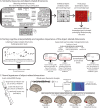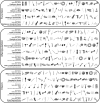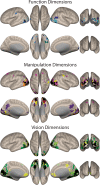Neural and behavioral signatures of the multidimensionality of manipulable object processing
- PMID: 37709924
- PMCID: PMC10502059
- DOI: 10.1038/s42003-023-05323-x
Neural and behavioral signatures of the multidimensionality of manipulable object processing
Abstract
Understanding how we recognize objects requires unravelling the variables that govern the way we think about objects and the neural organization of object representations. A tenable hypothesis is that the organization of object knowledge follows key object-related dimensions. Here, we explored, behaviorally and neurally, the multidimensionality of object processing. We focused on within-domain object information as a proxy for the decisions we typically engage in our daily lives - e.g., identifying a hammer in the context of other tools. We extracted object-related dimensions from subjective human judgments on a set of manipulable objects. We show that the extracted dimensions are cognitively interpretable and relevant - i.e., participants are able to consistently label them, and these dimensions can guide object categorization; and are important for the neural organization of knowledge - i.e., they predict neural signals elicited by manipulable objects. This shows that multidimensionality is a hallmark of the organization of manipulable object knowledge.
© 2023. Springer Nature Limited.
Conflict of interest statement
The authors declare no competing interests.
Figures





References
-
- Capitani E, Laiacona M, Mahon B, Caramazza A. What Are the Facts of Semantic Category-Specific Deficits? A Critical Review of the Clinical Evidence. Cogn. Neuropsychol. 2003;20:213–261. - PubMed
-
- Caramazza A, Shelton JR. Domain-Specific Knowledge Systems in the Brain: The Animate-Inanimate Distinction. J. Cogn. Neurosci. 1998;10:1–34. - PubMed
-
- Cappa SF, Frugoni M, Pasquali P, Perani D, Zorat F. Category-specific naming impairment for artefacts: A new case. Neurocase. 1998;4:391–397.
-
- Lambon Ralph MA, Patterson K. Generalization and differentiation in semantic memory. Ann. N.Y. Acad. Sci. 2008;1124:61–76. - PubMed
Publication types
MeSH terms
Grants and funding
LinkOut - more resources
Full Text Sources

